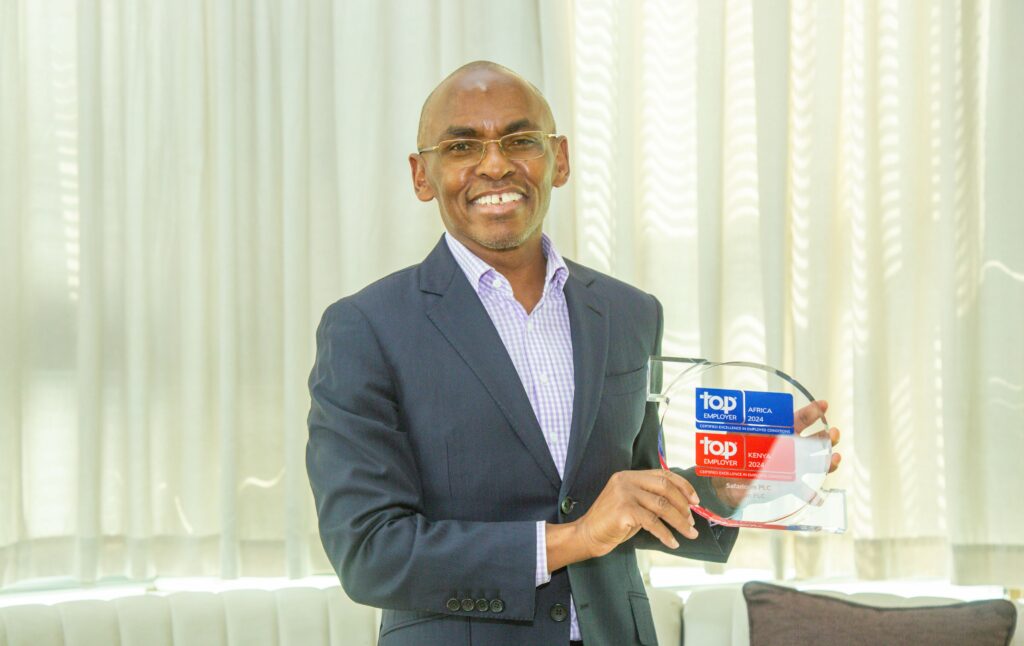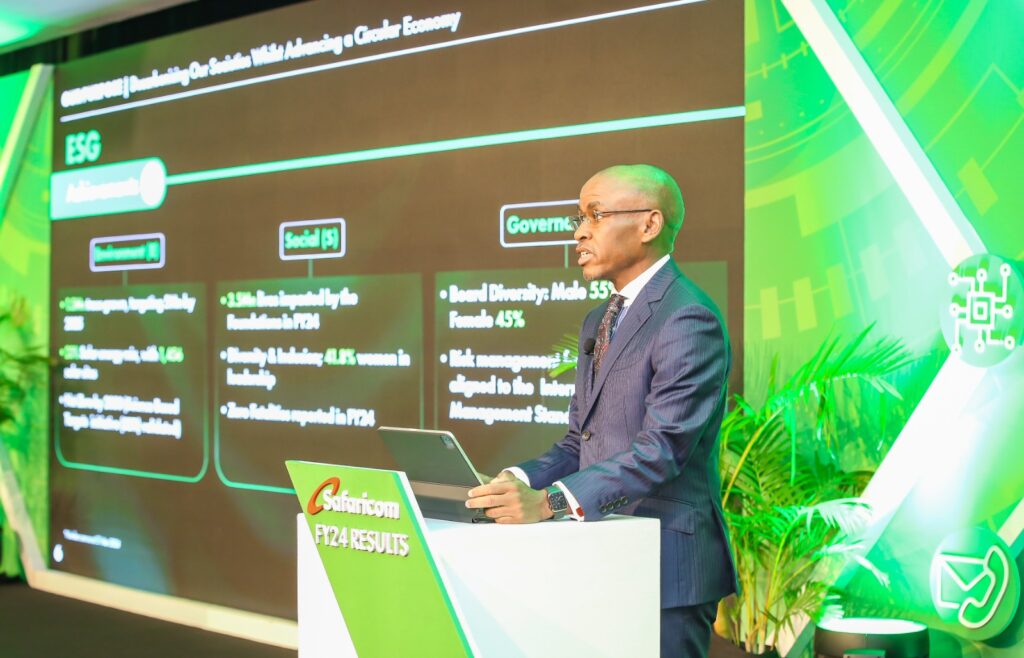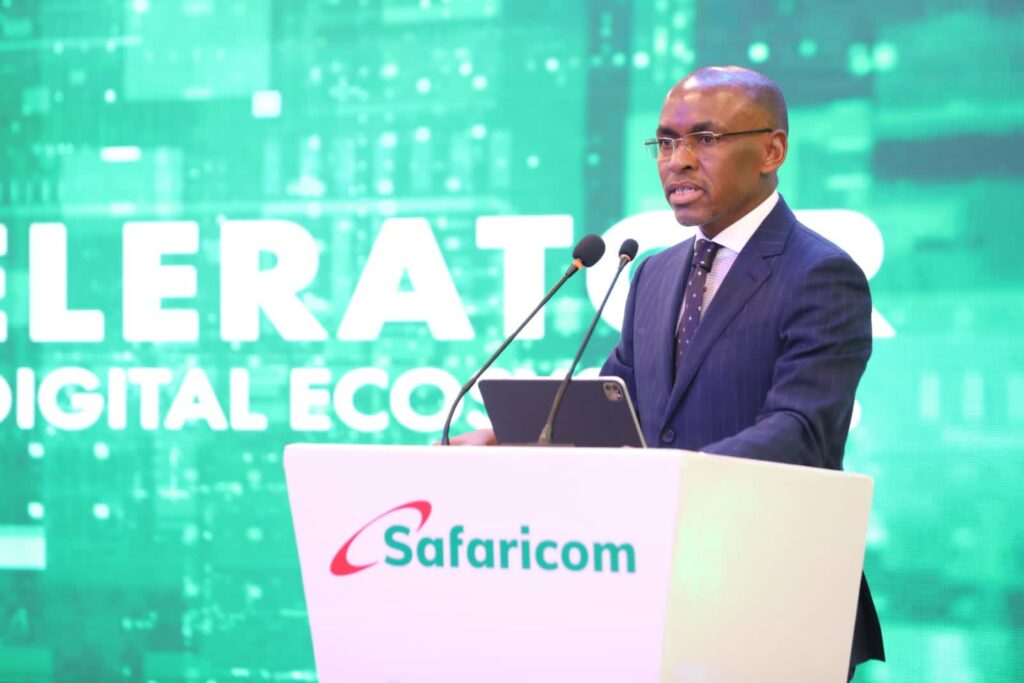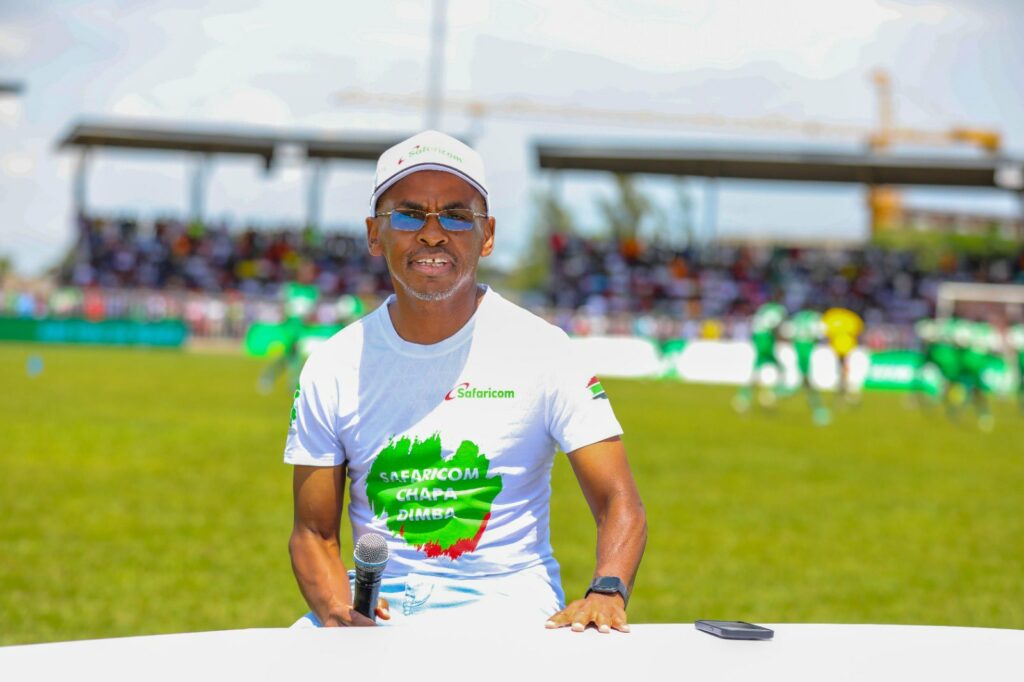advertisement
Big Tech Secret? Agile. Here’s How Safaricom Did It

Big tech companies thrive on innovation and adaptability. That’s because they are Agile. And Agile delivers. It allows them to respond quickly to market changes, put the customer first, break down silos for better collaboration, and even empower employees for greater ownership. Agile also provides a scalable framework for these often massive companies, giving them the flexibility to adapt quickly to changing needs.
It figures that it was time for Safaricom PLC to adopt Agile.
Peter Ndegwa is known for his calm demeanour, but the CEO of Kenya’s most ubiquitous company has led a radical internal transformation during his tenure. The company’s transition to an Agile operating model has been a complex journey filled with risks, moments of doubt, and hard-fought successes. Ndegwa opens up about the challenges of changing the course of an organisation known for its traditional success. He shares his motivations for initiating the Agile revolution, the strategies he used to gain buy-in, and the unexpected benefits the company has realized. Ndegwa also tackles questions about the future of Safaricom’s relationship with M-Pesa, his commitment to developing tech talent, and the personal side of leading such a high-impact organisation. This in-depth interview reveals a leader at once calculated and passionate, taking Safaricom into its next chapter as a purpose-led technology company.
advertisement
When I started as a journalist at Nation Media Group, someone quoted the then Editorial Director as saying NMG was like an elephant. Big, and difficult to turn. However, if you focused it in the right direction and yelled ‘Charge!’ it would be unstoppable and you would have to get out of its way. How do you run the Safaricom ‘elephant’ being the biggest employer for miles, and get it to charge in the right direction?
You are right. We have hired over 6,000 people directly, and about a million indirectly, numbers that add up when you consider supplier businesses and over 300,000 agents as part of our distribution infrastructure. 70,000 developers don’t work for Safaricom, but they work on the M-Pesa to connect the business ecosystem to M-Pesa. That’s who does all the integration. An organisation does not grow to 1 million people in a day. It happens over time, and you direct the ship as it grows. I came to Safaricom in 2020 with a specific vision – to be a purpose-led technology company. We needed to move to a technology business. Technology is about solutions, the customer journey, and customer experiences. Those solutions can’t be built in silos. We went into Agile to break down silos. It is not just a philosophy; it is a way of working in service of a goal.
When you came on board Safaricom as the new CEO, you had to work with the purpose you found – one that already existed, yet as CEO, you also had to come in and craft your own vision of the company. How did you inject Agile into this?
When you come into a large business like Safaricom, say, the elephant, you have to understand the elephant. As CEO, you need to understand the mandate of the stakeholders from the big investors to the board. When I came in, Michael Joseph (pioneering CEO and later Chairman of the Board of Directors) asked me about my vision. The thing about Safaricom is that it is a highly commercially successful business and delivers great results for shareholders. It is also ubiquitous. But we needed to take it to the next decade, hence technology as the source of inspiration. We leverage communications plus mobile financial services to allow people to connect.
I came in 2020 during the COVID-19 pandemic, which, as we know, accelerated the need for connection and communication. When we discussed our 2025 vision, we found we needed to serve people in a crisis. We expanded coverage and eliminated mobile transaction fees. What this did was allow us to see just how important technology was. That is when telcos realised they are an essential service. Alongside that was the revelation of how to solve people’s issues and customer issues. We saw customer obsession as the starting point which is our first mission. In the past, if we innovated, the product would have to pass through IT for vetting, which took so long that it was outdated by the time we were ready for the market. Agile allowed us to build as a team, designing solutions that took us to market faster. We also reflected on our overarching goals and what we wanted to achieve. We identified important levers, our 4Cs: attain sustained customer obsession, achieve deeper employee engagement, create a more intimate connection with our community and deliver enhanced value to our shareholders and partners.
advertisement

Two things. Is this what inspired the idea behind Safaricom becoming a technology company, two, how do you break silos?
We studied what technology companies like Netflix and Amazon were doing and looked at industries close to us. Our focus landed on Spark in New Zealand; a successful telco that went Agile and has been very successful since. We looked at companies that were born Agile – the OTTs that are fully tech.
advertisement
These would be Over-the-Top (OTT) communication apps like WhatsApp, Signal, and Zoom that offer free calls and messaging through user’s data/WiFi. They remove the need for relying on telecom voice minutes and SMS plans. These apps often add video chat, collaboration tools, and even payment services (further eroding services telcos traditionally profited from).
We knew we couldn’t be them, but we blended what they were doing with Spark’s vision, and we knew we had to adopt Agile. We then launched it in 2021. It was a massive bold move.
That it was, and not everyone was happy about it either.
I was portrayed as the fellow who came in with foreign concepts and ideas with allegations that I wanted to fire everyone. Journalists kept asking me how many people I’d be firing. Until I said I would actually be employing an extra 500 people. Even then, that still didn’t sound right to them. Well, we have not fired anyone. There were no forced exits, and we moved the IT team needle from 200 to 850; from a small department to one of the single largest teams, now even outsizing the network team. Remember before we became a technology company, the network was bigger because we were a telco. IT came in as we powered M-Pesa. Over time, we will become more IT-oriented with a connectivity base. The DNA of our business is, we connect people first, then we overlay it with connectivity. It is the case even with M-Pesa even as we move into credit, wealth and insurance.
As a move, it was also a shocker. Some were excited yet others felt vulnerable and apprehensive. When I first announced it, I could see people thinking I was smoking something! A few months in I told them Agile was not going anywhere. Unless I leave the organisation. But stakeholder engagement on why, and impact on the people, but mostly being very clear, helped. We outlined outcomes and had to tell employees what we wanted for customers which was simpler solutions, a quicker way of doing things. We helped to deliver Hustler Fund in literally 8 weeks from concept to launch. We didn’t have a team. We created one that was reabsorbed after delivery. Without Agile, we wouldn’t have delivered. Not if we were doing things like we traditionally did.
Walk me through the process of getting buy-in for Agile. Were there one-on-one sit-downs? Individual explanations and breakdowns or a series of big meetings to ring everyone to the same page and calming them down with promises of job retention? How did you handle it?
You are assuming I knew I wasn’t firing anyone. (Laughs). I had to take risks about whether people would lose jobs, or I would hire between 400-600 new IT talent, and think of how to fund that. The biggest change for people was titles. For example, someone would no longer be called a Senior Manager but, instead, I would be a Product Owner or Product Lead. That was a very big thing. The objection wasn’t really ‘I think I’ll lose my job,’ but rather, ‘What’s my job, and won’t I look smaller in society?’ to ‘What will my family say?’ Heads of the department became Tribe Leads. When stakeholders enquired, I mentioned Amazon and the Googles use terms like this. That this was the future the next generation was going into. And ExCo (executive committee) had to be convinced to tell the story about how this was how the future would look.
An Agile way of working is great for your career because you develop skills you didn’t have; you’ll improve your craft by exploiting it deeper. At the end of the day, you will have a better salary and title. We had to say, how do we digest this elephant? We came up with what we called Front Runners. We prioritized the business areas that were most urgent and had a higher value and went for fixed, mobile data, digital care and payments – M-Pesa. Only 4 tribe leads, who became guinea pigs. We learned from them, and ExCo was spread across. A set of squads (8-12 people) formed a tribe. We recruited around this and started contemplating the career model, which is about craft, and starting from a baseline to a master level. You play a role based on your level of craft and your remuneration is based on this. Salaries were not reduced. People were instead transitioned from Waterfall to Agile. It meant more work, and everyone watching the Front Runners, adopting a wait-and-see approach.

That sounds precarious.
Not really. Quite a number of the teams we chose wanted to be bold and involved. We faced challenges on the IT side until those on the Agile side began to observe they had more authority and growth. In turn, they enrolled others and we expanded into more than 20 tribes. Surprisingly, one of the areas we learned we were not good at as an organisation is UI/UX, yet we are supposed to be designing customer journeys for experiences with our apps. Yet we were not developing that critical skillset. We deepened our understanding of those areas. Beyond tribes and squads, we set up a big data centre of excellence instead of embedded into each team. We needed to build that as a craft.
As it has evolved, we have demonstrated value. Anxiety disappeared and engagement is back up. Change is not easy. They were very happy with the set structures. But then things became very fluid, and we even had pop-up squads working on projects like the Hustler Fund. There can be a feeling of having lost one’s home or department. People grow attached to these things. However, the fluidity allows you to create agility. The result is everyone has to review their backlog, including ExCo. It is very difficult to let go when you’re the one used to being in charge when you are the command-and-control type.
We invited General Robert Kibochi, the then Chief of the Kenya Defence Forces, to Safaricom. The military uses Agile very well. When they are given an assignment by a commander-in-chief, they resource in a couple of days and move fast. There is no small or big role in a squad or a tribe which creates a level of respect. Today, 46 per cent of Safaricom PLC Kenya is Agile while M-PESA Africa is 100 per cent Agile. We expect Safaricom PLC Kenya to be fully Agile by the end of FY25 and look forward to Safaricom Ethiopia commencing its transition into an Agile organisation.
How did you, and do you now measure success when all the metrics are changed and have shifted especially if there was upheaval to set it off?
You test the Agile principles as you develop Front Runners to show that organisation this was a serious transformation. They became our Agile ambassadors and supported us in spreading the Agile spirit. They facilitated sessions in training boot camps of subsequent roll-out waves. We also identified critical elements and received feedback that we wouldn’t have identified without the frontrunners, ensuring a smoother rollout of subsequent tribes. Once we identified Agile champions, we set up a microsite explaining the new operating model and people stories, while the entire ExCo team were evangelists within their respective teams. We are still in the process of transitioning since cultural and mindset changes take time to be fully embedded within the organisation – but we are on a good trajectory.
One of our focus areas was to get our IT ready for Agility by de-coupling systems or introducing microservices. This allows us to transfer more ownership of IT systems to the different tribes and squads. It is a major effort and is still underway. Another focus was on building tech talent and enforcing the allocation of our software developers within the squads to truly establish cross-functional teams. The Quarterly Business Review (QBR) process has also helped allocate resources, align on targets for the next quarter and led by finance with input from human resources (HR).
Some of the Tribes are now achieving their mission, which looked impossible initially. I had to be the bearer of bad news along the way, telling them when it was going nowhere, reminding them Agile was here to stay. One of the ways we reassured people was the concept of 1 More Skill. I’m currently learning AI. I know for me to operate in a tech environment, there are certain basic skills I need. People learned it wasn’t the end of the world. That this was doable. Results on the business side have been very strong but there’s still work to be done on UI/UX.

Safaricom is quite successful when it comes to customer care. It is the one thing you are known for.
The idea is to be customer-obsessed, and everyone is focused on that, but based on business as usual. As we move towards solutions for customers, we could do more. One of the big areas is automation and digitisation. This enables experiences. When you call a care centre, the more data enabled the better. The agent can use this to serve the customer earlier and better rather than going searching. There’s still work to be done. The secret is using data and digitising and automating.
At the beginning of Agile, three years ago, we had three people in the big data team. Today, we have 38 data scientists and data engineers. We have developed 100 data models and are diving into AI in a big way to detect fraud. We are developing use cases for big data and ensuring an AI-enabled Zuri in future. Customer value management is key for us; knowing the segments, and which key products and services they want. A product like Fuliza, for instance, allows us to assist the customer in the process of buying when they don’t have enough money to complete the transaction. And it is all automated because the credit check has already been done, allowing them to finish the transaction.
Do you ever feel the weight of these jobs on your shoulders? So many people depend on you to make this work.
The buck stops with you as CEO. You have to feel the weight. The responsibility and accountability make you realise the importance of your role and that you have to make it work. I also have to take risks. If I don’t, the organisation won’t because they’re watching you. You know what they say – leaders are watched like how people window shop. If they see doubt – (laughs), especially in that whole journey of Agile… You enrol others. Your team, those who are not committed go talk to them, and use advocates then go and yell at those watching from the sidelines.
Once they realise they are left behind, they will wake up. Fortunately, I had strong supporters. Some of the initial Front Runners were promoted because they took the risk. There is external pressure as well. I had to ignore social media. People would ask me if I read articles, and I would go – which one? You have to hold your nerve but also get advice from successful Agile implementors. It is the bravery to go all the way. We digested the whole animal over time.
Why do you think your employees are so attractive to Big Tech? They keep coming knocking and poaching your people. How do you keep your talent?
When Agile showed up – some fellows went and jumped – they jumped and went to all the places that were set up. People were very surprised at this. I said we should be developing talent for the industry. We are the largest tech business and fintech operation. What do you expect? We should be developing talent for the industry. If they come to take our people, it’s fine. Agile will allow you to do things you have never done. People began to see opportunities. Young people don’t just want money.
They want opportunities to see their skill being used. We partnered with 14 companies to allow university students to understand their careers post-university. The wave of wanting to leave died down 6 months into Agile. After a year, those who left wanted to come back. Now, our attrition is very low. We give the largest number of opportunities as the largest employer. We work with the government and the private sector and in Agile you participate in different teams.

So, you don’t just work for a cross-functional team. You ARE a cross-functional team.
Yes. And you can’t hold people back. All this is raising the craft of the industry. So many people who have left are now on the other side and we now have people who have the same standard as we do. That’s why you have to hold your nerve and trust that you are doing the right thing. The biggest decision we made was to elevate the role of IT 3X. Now we deploy solutions that work – they don’t just sell. Now we can absorb work without increasing numbers by moving talent around. It has been a fantastic journey.
I ask this because I can’t seem to get a straight answer online or from anyone. It is not necessarily related to Agile, but is Safaricom ever going to split from M-Pesa?
It’s a valid question. Both journalists and investors keep asking. Safaricom started M-Pesa. And has transformed the landscape as far as fintech is concerned. Combining them has allowed us to deliver solutions no other corporation delivers. We believe keeping them together has worked for customers and shareholders. Others, like Airtel and MTN, have done it. If there was a reason to split – meaning if it were up to customers – that if we split from M-Pesa then customers would get more value – they don’t; we would do it. But we operate them separately as teams. Does it add value for society without creating unintended consequences? If it is possible to do that, then we will do it. At this stage, we do not see the benefit of it.
What is it about Agile that appeals to you so intensely?
I’ve gone through the pain… (laughs). When you think about this curve of change, where anxiety and fear of the unknown live, to becoming an advocate, that is where change happens.
Have you finally found the perfect balance between risk and innovation?
There’s no perfect balance. Commercial risk is very easy to judge. Compliance is different. Will you endanger other people’s money or systems in place? Those are not black and white. Risk appetite is based on what you want to deliver. You know, people say Safaricom should be smaller. No. We need 5 to 10 more Safaricoms. We are not just one company. We support the ecosystem. People should see the ecosystem when it comes to Safaricom. Not the company. It is just an expression of the orchestrator but those who benefit are much more than that.
What do you do for fun?
I watch Arsenal whether they win or not – a team that allows you to hope they will be better in the future. You have to keep yourself mentally and emotionally fit. I also travel – when we lived abroad, we travelled a lot, and I could write a book about the countries I’ve been to from Israel, and Ukraine to Russia. I wish I could read more, especially on leadership and psychology. The thing about books is they need time. With the internet though, I have small bites.
I recommend Blinkist, the popular ‘CEO’ app that summarises books for you in 15 minutes.